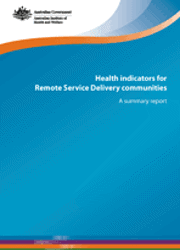Summary
The National Partnership Agreement on Remote Service Delivery (NPA RSD) was one aspect of a broader government agenda to reduce the gap in Indigenous disadvantage. It was implemented between June 2009 and June 2013 in 29 priority remote communities across New South Wales, Queensland, Western Australia, South Australia and the Northern Territory. To inform the implementation of the NPA RSD, the Australian Institute of Health and Welfare (AIHW) provided selected data for each RSD community in 2010. Data were then updated in 2012 to inform the NPA RSD evaluation process. The evaluation was conducted in 2013, with a final report released in July 2014 (Australian Government 2014). This report summarises the data provided by AIHW for this evaluation. It presents data around antenatal care, live births, low birthweight babies, hospitalisations (all and selected causes), disability, mortality, child protection, juvenile justice, alcohol and other drug use, and aged care. Various issues impact on the data presented. In particular, there were no community level data in most administrative data collections, so communities were approximated by the statistical local area (SLA) or postcodes in which the community was located.
Key findings
RSD SLAs have higher teenage fertility rates
- In 2008-2009, RSD SLA teenage fertility rates were much higher than the national rate as a whole. Most were also higher than the national Indigenous teenage fertility rate.
- In 2009, in most RSD SLAs, the rate of low birthweight babies born to Indigenous mothers was higher than Indigenous jurisdictional and national rates.
RSD SLAs have higher hospitalisation rates
- In 2010-11, almost all RSD SLAs had higher hospitalisation rates than the national Indigenous rate. Walgett SLA had a significant decrease in hospitalisation rates between 2003-04 and 2010-11.
- Hospitalisation rates were generally much higher in RSD SLAs when dialysis was included. Indigenous Australians are more likely than other Australians to be hospitalised for diabetes. This may explain the high rates of dialysis hospitalisations.
- Hospitalisation rates for potentially preventable conditions in RSD SLAs were generally higher than Indigenous jurisdictional rates; except in Lajamanu and Ngukurr.
- Hospitalisation rates for diseases associated with poor environmental health were higher in RSD SLAs compared with Indigenous rates nationally.
- In 2008-09 to 2010-11, Indigenous residents of RSD SLAs were more than 6 times as likely to be hospitalised for diabetes as other Australians nationally. They were also more likely to be hospitalised for assault (20 times as likely), care involving dialysis (10 times as likely) and alcohol-related conditions (5 times as likely).
RSD SLAs have higher death rates
- In 2003-2010, Indigenous residents of RSD SLAs experienced an all-cause death rate over 3 times that of other Australians nationally. They also died from preventable diseases at 10 times the rate of other Australians nationally.
Preliminary material: Acknowledgments; Abbreviations; Symbols
1 Introduction
- Data issues to consider
- Methods
- Data quality
2 Health indicators for RSD communities
- Antenatal care
- Births
- Low birthweight babies
- Hospitalisations
- Disability
- Mortality
- Child protection
- Juvenile justice supervision
- Alcohol and other drug treatment
- Aged care
3 Discussion
- Assessing the impact of programs
Appendixes
Appendix A: Tables
Appendix B: Methods
End matter: Glossary; References; List of tables; List of figures; Related publications



